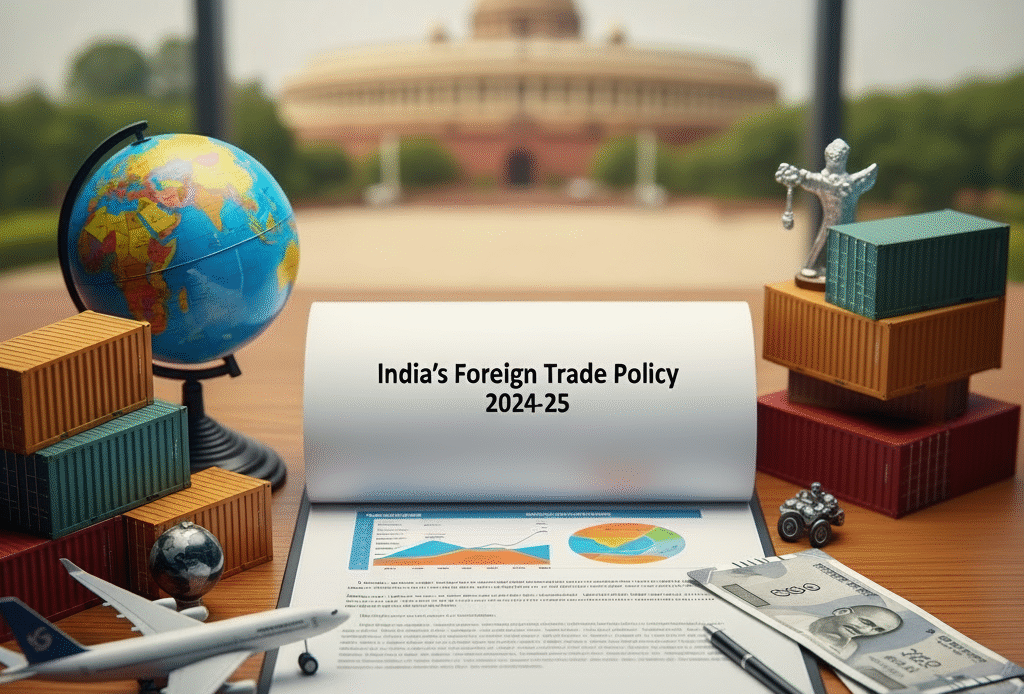India’s Foreign Trade Policy 2024–25: A Comprehensive Overview
Akhilesh Singh – ILS Law College, Pune
Ease of Doing Business
A central objective of the Foreign Trade Policy (FTP) 2024–25 is to make international
trade more seamless by leveraging digitalization. Many export approval processes and duty exemption schemes have been automated through IT systems, ensuring faster processing, lower compliance costs, and reduced manual intervention.
The policy also makes notable advances in merchanting trade, which allows the shipment of goods from one foreign country to another through an Indian intermediary, without the goods physically entering Indian ports. The range of items permitted under merchanting trade has been significantly expanded, creating new opportunities for Indian businesses to position themselves as intermediaries in global supply chains.
In recent years, parallel reforms have reinforced this drive toward efficiency. Processes have been increasingly digitised to cut down paperwork and speed up approvals. Exporters can now apply online for all Directorate General of Foreign Trade (DGFT) schemes, supported by a centralised helpdesk to resolve trade-related queries. These measures collectively align with India’s broader ambition of becoming a global hub for ease of doing business.
Emerging Areas
The government recognises e-commerce exports as a critical growth driver requiring
dedicated policy intervention. With e-commerce exports projected to reach US$200–300 billion by 2030, the FTP lays down a blueprint for creating e-commerce export hubs, equipped with support systems for payment reconciliation, bookkeeping, returns
management, and export entitlements.
In addition, outreach programs are being conducted to integrate weavers, artisans,
jewellery designers, and other traditional sectors into the e-commerce ecosystem, opening global markets to small producers. A notable digital leap is the planned integration of Courier and Postal exports with ICEGATE, enabling small exporters to access FTP benefits with greater ease.
India is also strengthening its SCOMET (Special Chemicals, Organisms, Materials,
Equipment, and Technologies) policy to ensure better alignment with international
standards. This harmonisation is expected to enhance the credibility of Indian exports in sensitive and high-tech sectors, improving competitiveness in global markets.
Incentive Schemes for Exporters
Exporters in India can already benefit from multiple incentive and remission schemes.
Awareness of these initiatives is essential for businesses to optimise costs.
a) Rebate of Duties & Taxes on Exported Products (RoDTEP): Introduced in 2020, RoDTEP replaced the Merchandise Exports from India Scheme (MEIS). It reimburses exporters for duties and taxes paid during production, ensuring Indian goods remain cost-competitive abroad.
b) Goods and Services Tax (GST): Since 2017, exports have been treated as “zero-rated supply”, meaning no GST is levied on outbound goods or services. Exporters are also entitled to input tax credit, lowering their overall tax burden.
c) Market Access Incentive (MAI): Provides financial assistance for international marketing activities, including trade fairs, branding exercises, and market research.
These incentives not only lower operational costs but also equip exporters with tools to build stronger global market presence.
Duty Exemption and Remission Schemes
The Ministry of Commerce and Industry has also designed schemes to allow duty-free
import of raw materials and inputs required for producing export goods. In line with the Digital India vision, these schemes are being transitioned to online platforms for faster and more transparent approvals.
Duty Exemption Schemes
- Advance Authorisation Scheme (AAS): Allows duty-free import of inputs used in manufacturing export goods.
- Duty-Free Import Authorisation (DFIA): Extends exemptions to both inputs and capital goods, including machinery used for production.
Duty Remission Schemes - Duty Entitlement Passbook Scheme (DEPB): Offers credit against export duties, reducing costs for exporters.
- Duty Drawback Scheme (DBK): Refunds duties paid on imported inputs used in manufacturing exported goods.
These measures help exporters reduce their production costs and maintain competitiveness in international markets.
Future Roadmap for India’s Trade Policy
Micro, Small, and Medium Enterprises (MSMEs) are the backbone of India’s exports,
contributing nearly 50% of total exports and 29% of GDP. The FTP 2024–25 is positioned as a roadmap for these enterprises to play a greater role in India’s global trade strategy. To achieve the ambitious target of US$2 trillion in exports by 2030, India will need sustained efforts in:
- Automation and IT-driven trade facilitation
- Lowering transaction costs
- Promoting district-level export hubs
- Strengthening research and development
- Encouraging e-commerce penetration in traditional industries
The policy also signals a shift away from a subsidy-based regime toward long-term structural reforms aimed at enhancing competitiveness and resilience of Indian exporters.
Conclusion
The Foreign Trade Policy 2024–25 reflects India’s determination to position itself as a
central player in global trade. By emphasising digitalisation, e-commerce, merchanting
trade, and export facilitation, while also supporting exporters with duty remission and
incentive schemes, the policy strikes a balance between immediate relief and long-term strategic growth.
For India to realise its vision of becoming a US$2 trillion export economy by 2030,
execution will be critical. Continued coordination between the government, industry
stakeholders, and MSMEs will determine whether India can fully harness its demographic and technological advantages.
In essence, the FTP 2024–25 is not just a policy document—it is a blueprint for India’s
trade future, anchoring the country’s economic aspirations firmly within the framework of global commerce.


